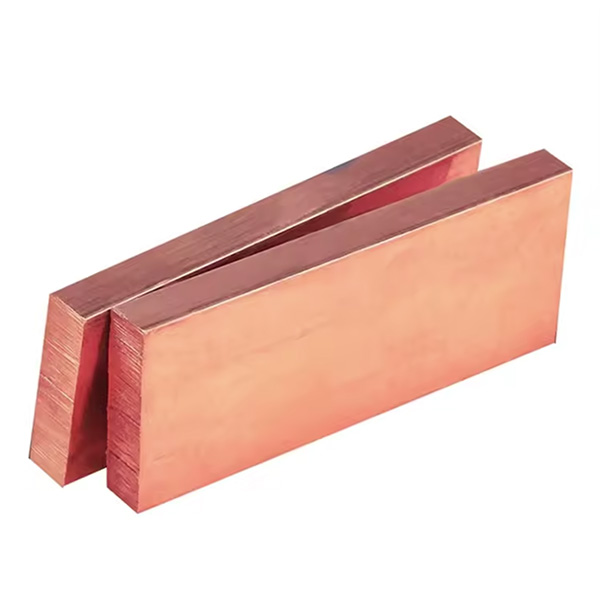Copper flat busbar is a type of electrical conductor commonly used in electrical power distribution systems. It is serve as conductors of significant electrical currents within switchboards, distribution boards, substations, and other electrical equipment.
Copper flat busbars are used in various electrical industries, including power generation, transmission, and distribution, as well as in electrical panels for industrial, commercial, and residential buildings.
Features of copper flat busbar
High Electrical Conductivity: Copper is known for its excellent electrical conductivity, which allows for efficient transmission of electrical power with minimal losses.
Low Electrical Resistance: The low resistance of copper helps reduce energy losses in the form of heat, ensuring efficient power distribution.
Excellent Thermal Conductivity: Copper's high thermal conductivity enables effective dissipation of heat generated during electrical operations, preventing overheating and maintaining system reliability.
Corrosion Resistance: Copper exhibits excellent corrosion resistance, particularly in indoor environments. This property ensures long-term durability and reliability of busbar systems.
Ease of Fabrication: Copper busbars are relatively easy to fabricate into various shapes and sizes, including flat configurations, making them versatile for different applications.
Mechanical Strength: Copper flat busbars offer sufficient mechanical strength to withstand the mechanical stresses and vibrations encountered in electrical systems.
Compatibility with Joining Methods: Copper busbars can be easily joined using methods such as soldering, brazing, welding, or mechanical connections, facilitating installation and maintenance.
Compact Design: Flat busbars have a compact design, allowing for efficient use of space within electrical enclosures and equipment.
Customizable Dimensions: Manufacturers can produce copper flat busbars in a wide range of thicknesses, widths, and lengths to meet specific design requirements and current-carrying capacities.
Cost-Effectiveness: While copper may have a higher initial cost compared to some other materials, its long-term reliability, durability, and performance often make it a cost-effective choice for electrical applications.
Application of copper flat busbar
Power Distribution Systems: Copper flat busbars are widely used for distributing electrical power within switchboards, distribution boards, panelboards, and substations. They efficiently carry high currents from the power source to various loads while minimizing energy losses.
Industrial Equipment: In industrial settings, copper flat busbars are used in equipment such as motor control centers, variable frequency drives (VFDs), control panels, and power distribution cabinets. They provide a reliable and efficient means of supplying electricity to industrial machinery and equipment.
Renewable Energy Systems: Copper busbars are essential components in renewable energy systems such as solar power plants and wind farms. They facilitate the efficient transmission of electricity generated by solar panels, wind turbines, or other renewable energy sources to the grid or storage systems.
Data Centers: Copper flat busbars play a critical role in data center infrastructure, where reliable and high-capacity power distribution is essential to support the operation of servers, networking equipment, and other IT systems. They help maintain uptime and ensure uninterrupted power supply to critical equipment.
Electric Vehicles (EVs): In electric vehicles, copper busbars are used to distribute high currents from the battery packs to the various components, including the motor controller, inverters, and charging systems. Their high conductivity and thermal properties help optimize the performance and efficiency of EV powertrains.
Electrical Panels and Enclosures: Copper flat busbars are commonly found in electrical panels and enclosures for residential, commercial, and industrial applications. They provide a reliable and compact solution for organizing and distributing electrical connections within these enclosures.
Power Generation Facilities: Copper busbars are used in power generation facilities such as hydroelectric plants, thermal power plants, and nuclear power plants. They help transport electricity generated by generators or turbines to transformers and other equipment for further distribution.
Railway and Transportation Systems: In railway and transportation systems, copper busbars are utilized for power distribution in trains, trams, and electric buses. They ensure efficient and reliable power delivery to traction motors and other electrical systems onboard.
Telecommunications: Copper busbars are used in telecommunications infrastructure for distributing power to equipment such as amplifiers, routers, and switches in data centers, telecom towers, and central offices.
Battery Energy Storage Systems (BESS): Copper busbars are integral components in battery energy storage systems used for grid stabilization, load balancing, and renewable energy integration. They facilitate the efficient transfer of electrical energy between batteries and the grid or connected loads.
Copper clad aluminum common size and current carrying capacity
|
Size(mm) |
Ampacity(A) |
|
15 x 3 |
181 |
|
25 x 3 |
239 |
|
30 x 3 |
293 |
|
30 x 4 |
405 |
|
40 x 4 |
475 |
|
40 x 5 |
517 |
|
50 x 5 |
656 |
|
50 x 6 |
726 |
|
60 x 6 |
858 |
|
60 x 8 |
1005 |
|
60 x 10 |
1124 |
|
80 x 6 |
1145 |
|
80 x 8 |
1264 |
|
80 x 10 |
1420 |
|
100 x 6 |
1392 |
|
100 x 8 |
1565 |
|
100 x 10 |
1739 |
|
120 x 10 |
1814 |
|
120 x 12 |
2002 |


